
Padmasambhava, also known as Guru Rinpoche and the Lotus from Oḍḍiyāna, was an tantric Buddhist Vajra master from India who may have taught Vajrayana in Tibet. According to some early Tibetan sources like the Testament of Ba, he came to Tibet in the 8th century and helped construct Samye Monastery, the first Buddhist monastery in Tibet. However, little is known about the actual historical figure other than his ties to Vajrayana.
The Drukpa Kagyu, or simply Drukpa, sometimes called either Dugpa or "Red Hat sect" in older sources, lineage is a branch of the Kagyu school of Tibetan Buddhism. The Kagyu school is one of the Sarma or "New Translation" schools of Tibetan Buddhism. The Drukpa lineage was founded in the Tsang region of Tibet by Tsangpa Gyare (1161–1211), and later became influential in Ladakh and Bhutan.

Trashiyangtse District is one of the twenty dzongkhags (districts) comprising Bhutan. It was created in 1992 when Trashiyangtse district was split off from Trashigang District. Trashiyangtse covers an area of 1,437.9 square kilometres (555.2 sq mi). At an elevation of 1750–1880 m, Trashi yangtse dzongkhag is rich of culture filled with sacred places blessed by Guru Rimpoche and dwelled by Yangtseps, Tshanglas, Bramis from Tawang, Khengpas from Zhemgang and Kurtoeps from Lhuentse.
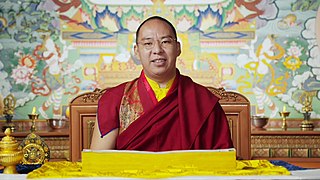
Chökyi Gyalpo, also referred to by his secular name Gyaincain Norbu or Gyaltsen Norbu, is considered the 11th Panchen Lama by the government of the People's Republic of China (PRC). He is also the vice president of the Buddhist Association of China. Gyalpo is considered by some to be a proxy of the Chinese government.

The Nyingma school is the oldest of the four major schools of Tibetan Buddhism, founded by Vajrayana revealer Guru Padmasambhava. "Nyingma" literally means "ancient," and is often referred to as Ngangyur, "school of the ancient translations" or "old school". The Nyingma school is founded on the first translations of Buddhist scriptures from Sanskrit into Old Tibetan in the eighth century, during the reign of King Trisong Detsen. The Tibetan alphabet was created for this endeavour, and the classical variety of the Tibetan language standardised.
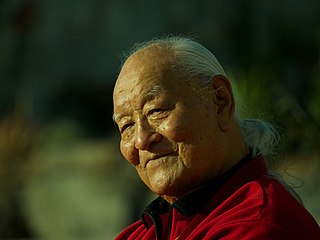
Namkhai Norbu was a Tibetan Dzogchen master, Professor of Tibetan and Mongolian Language and Literature at the Naples Eastern University, and a leading authority on Tibetan culture, particularly in the fields of history, literature, traditional religions, and Traditional Tibetan medicine.
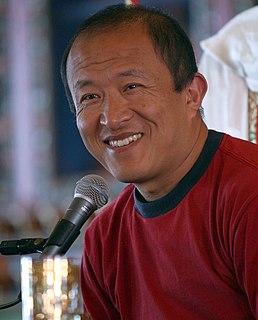
Dzongsar Jamyang Khyentse Rinpoche, also known as Khyentse Norbu, is a Tibetan/Bhutanese lama, filmmaker, and writer. His four major films are The Cup (1999), Travellers and Magicians (2003), Vara: A Blessing (2013), and Hema Hema: Sing Me a Song While I Wait (2017). He is the author of What Makes You Not a Buddhist (2007) and many other non-fiction works about Tibetan Buddhism.
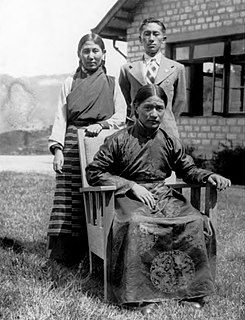
Kyabje Dudjom Jigdral Yeshe Dorje was known as Terchen Drodül Lingpa and as Dudjom Rinpoche. He is considered by many Tibetan Buddhists to be from a line of important Tulku lineage, and a renowned Tertön. Lineage wise, he was a direct incarnation of both Padmasambhava and Dudjom Lingpa (1835–1904). He was a Nyingma householder, yogi, and a Vajrayana and Dzogchen master. According to his disciple Khenpo Tsewang Dongyal, he was revered as "His Holiness" and as a "Master of Masters".
Chatral Sangye Dorje Rinpoche was a Dzogchen master and a reclusive yogi known for his great realization and strict discipline. Rinpoche was one of the few living disciples of Khenpo Ngawang Pelzang and was widely regarded as one of the most highly realized Dzogchen yogis. In addition to his relationship with Khenpo Ngagchung, Chatral Sangye Dorje also studied with some of the last century's most renowned masters, including Dudjom Jigdral Yeshe Dorje, Dzongsar Khyentse Chökyi Lodrö, and the famed Kunzang Dekyong Wangmo. Rinpoche was one of the primary lineage holders of the Longchen Nyingthig, and in particular the lineage that descends through Jigme Lingpa's heart son Jigme Gyalwe Nyugu and then on to Patrul Rinpoche.
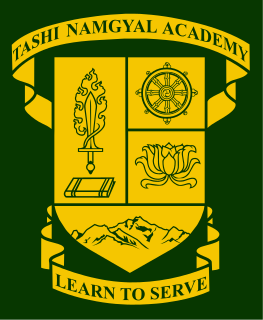
Tashi Namgyal Academy (TNA) is a public school in the Himalayan state of Sikkim in India. It was founded in 1926 by the late Sir Tashi Namgyal, KCSI, KCIE, the 11th consecrated Ruler of Sikkim. It is an autonomous English-medium, co-educational and residential-cum-day school.
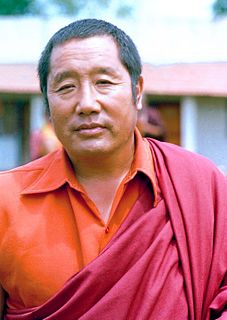
Kyabjé Drubwang Padma Norbu Rinpoche, 1932 – 27 March 2009, was the 11th throneholder of the Palyul Lineage of the Nyingma school of Tibetan Buddhism, and said to be an incarnation of Vimalamitra. He was widely renowned in the Tibetan Buddhist world as a master of Dzogchen. He was one of a very few teachers left from his generation who received all his training in Tibet under the guidance of what Tibetan Buddhists consider to be fully enlightened teachers.
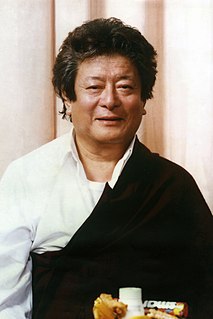
Kyabje Dungse Thinley Norbu Rinpoche was a major modern teacher in the Nyingma lineage of Tibetan Buddhism, and patron of the Vajrayana Foundation. He was the eldest son of Dudjom Rinpoche, the former head of the Nyingma lineages, and also the father of Dzongsar Jamyang Khyentse Rinpoche and Dungse Garab Rinpoche. His association with the Dudjom Lineage is a long one: he is held to be the incarnation of Tulku Drime Oser, who was one of seven sons of Dudjom Lingpa. He also was considered to be an emanation of Longchen Rabjam, the great 14th-century Nyingma scholar and siddha who composed the Seven Treasuries. He died in California on December 26, 2011, according to the Tibetan Buddhist Lunar Calendar the 2nd day of the 11th month of the Iron Rabbit year. His cremation was held in a public buddhist cremation ceremony in Paro, Bhutan on March 3, 2012, which was attended by several thousand people, including some of Bhutan's royal family.
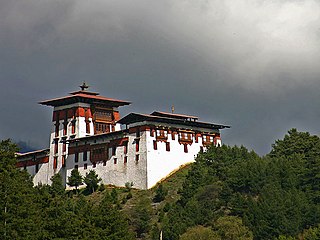
Jakar is a town in the central-eastern region of Bhutan. It is the district capital of Bumthang District and the location of Jakar Dzong, the regional dzong fortress. The name Jakar roughly translates as "white bird" in reference to its foundation myth, according to which a roosting white bird signalled the proper and auspicious location to found a monastery around 1549.
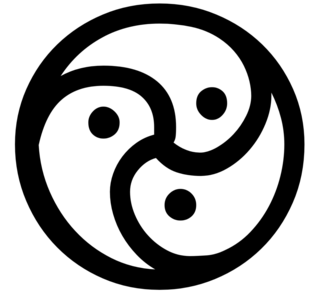
The Gankyil or "wheel of joy" is a symbol and ritual tool used in Tibetan and East Asian Buddhism. It is composed of three swirling and interconnected blades. The traditional spinning direction is clockwise, but the counter-clockwise ones are also common.

Kyichu Lhakhang, is an important Himalayan Buddhist temple situated in Lango Gewog of Paro District in Bhutan.

Rinpung Dzong is a large dzong - Buddhist monastery and fortress - of the Drukpa Lineage of the Kagyu school in Paro District, Bhutan. It houses the district Monastic Body and government administrative offices of Paro Dzongkhag. It is listed as a tentative site in Bhutan's Tentative List for UNESCO inclusion.

Gonpo Tseten Rinpoche (1906–1991) was a Dzogchen master, author, painter, sculptor, and teacher of the Nyingma school of Tibetan Buddhism.

Nalanda Buddhist Institute (NBI), also known locally as Daley Goenpa or Dalida, is a Buddhist monastic school (shedra) in the western part of the Punakha District (Dzongkhag) in Bhutan. It is below Talo Monastery and above Walakha, about a 25-minute drive from the main highway to Punakha. The name Nalanda means "insatiable giving".

The Kajang High School, better known by its abbreviation of KHS in English and SMKTK in Bahasa Malaysia, is a national secondary school located in the town of Kajang, municipality of Kajang Municipal Council. It is the oldest school in Kajang and the district of Hulu Langat when the first block was erected at Mile 14 Cheras Road, opposite Jamek Mosque of Kajang.
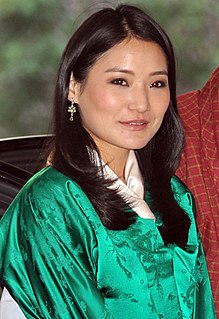
Jetsun Pema is the Druk Gyaltsuen of Bhutan, as the wife of King Jigme Khesar Namgyel Wangchuck. She is currently the youngest queen consort in the world. She and the King have two children: Prince Jigme Namgyel Wangchuck, the heir apparent to the Bhutanese throne, and Jigme Ugyen Wangchuck.


















